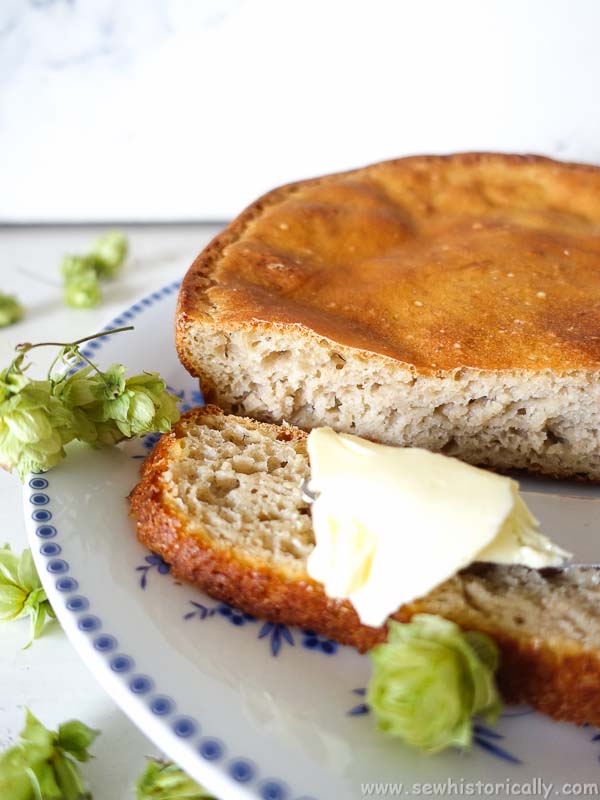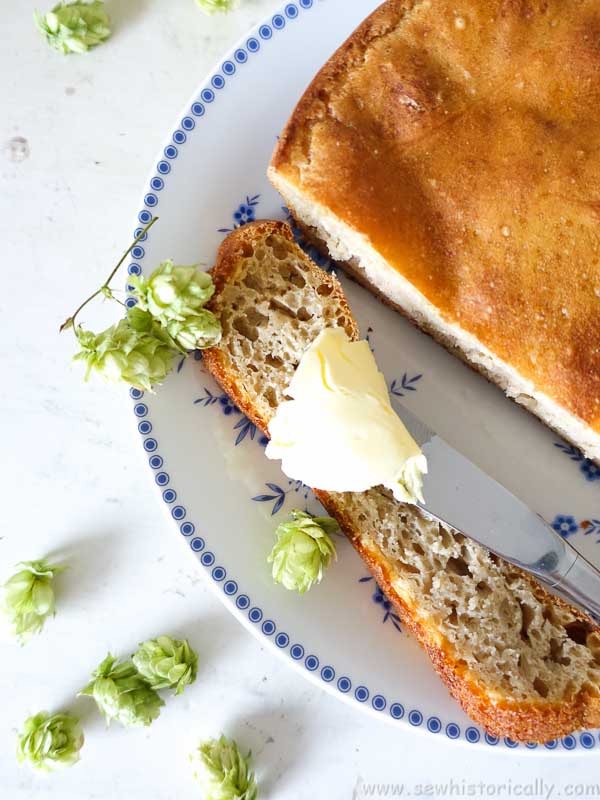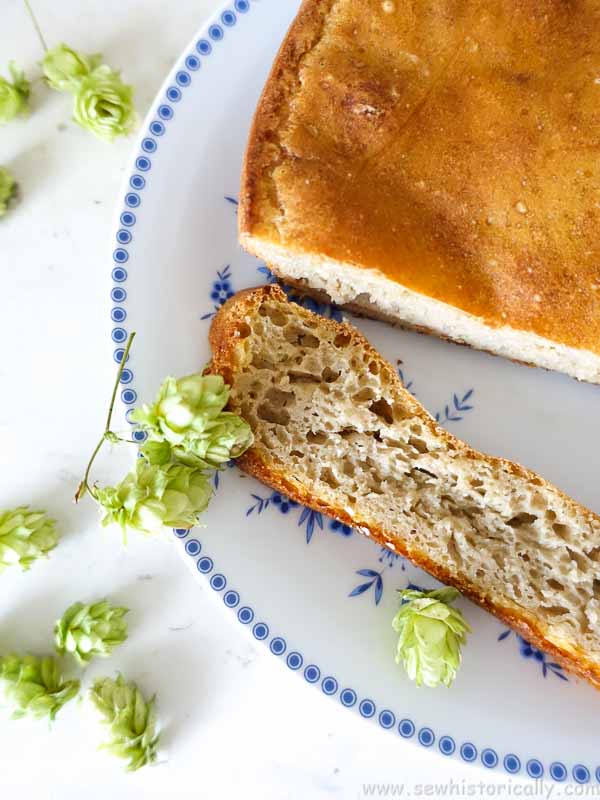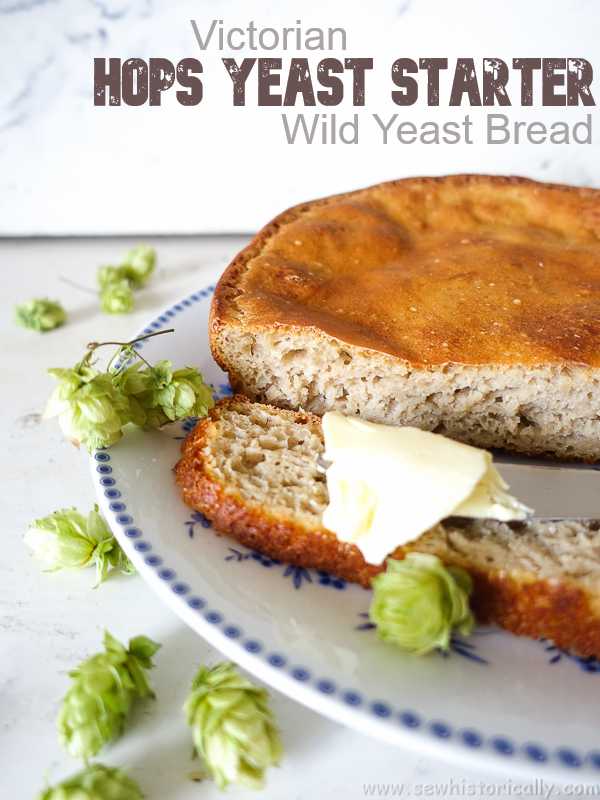Make delicious wild yeast bread with hops yeast water starter from scratch!
The Victorians usually made their own yeast at home from scratch, even if commercial yeast was already available back then. But they preferred bread with homemade yeast because it was more flavorful and healthier.
In the Victorian era, homemade yeast from scratch usually contained hops. Just like beer, hops yeast bread tastes bitter because of the hops. This bitter taste is unusual in bread but not in an unpleasant way. And besides the bitter taste, hops yeast bread is also very moist compared to other wild yeast breads.
Related: 10 Victorian Bread Recipes Without Commercial Yeast
Homemade hops yeast starter is very active and rises fast. In fact, it’s the fast rising homemade wild yeast starter I’ve tried so far. Once the hops yeast starter is ready, hops yeast bread rises even better than bread with commercial yeast! And besides, the hops prevent the growth of mold, the sour-tasting acetic acid bacteria of sourdough and other unwanted bacteria. And wild yeasts thrive in hops water. But you shouldn’t keep homemade wild yeast starter with hops for too long because it becomes sour soon. So it’s better to make hops yeast starter from scratch every time.
‘In order to make yeast, all we need is a suitable food, moisture, and the proper degree of warmth. Free access to the air assists in its growth, and if hops, salt, or ginger are added certain undesirable acid fermentations are checked, thus preventing sourness in the bread and at the same time adding certain agreeable flavors.’ (Manual for Army Bakers, 1910, p. 27)
This is the second time that I tried Victorian hops yeast starter from scratch. Last time it failed – the bread smelled and tasted bad – because I made starter with potatoes and used wild hops. But this time I made Victorian hops yeast starter without potatoes and the hops yeast bread from scratch turned out delicious!
Hops Yeast Starter – Ingredients
Why Add Hops To Homemade Yeast Starter
Hops prevent the growth of bad bacteria as well as good bacteria, such as lactic acid bacteria as in sourdough. So hops water makes sure that only wild yeasts can grow and leaven the bread.
‘Hops do not furnish food for the yeast plant, but they add a pleasant flavor. Their greatest usefulness, however, lies in the fact at they contain than element (called lupulin) which is active in checking the acetic and lactic fermentations that generally accompany the alcoholic fermentation which always takes place as an incident to the growth of the yeast plant.’ (Manual for Army Bakers, 1910, p. 28f)
What Hops To Use: Fresh Hops, Wild Hops Or Commercial Hops?
Last time I used wild hops for my homemade hops yeast starter. But wild hops can add a bad taste to bread. Therefore, I used commercial hops this time. For homemade yeast starter you need fresh hops: Fresh hops are green and smell of garlic with hints of lemon. Hops are ripe in late August or September. To make homemade yeast starter with fresh hops you can either grow your own or ask a hop farmer if you can have a handful of fresh hops.
‘The best hops are of a bright color, between yellow and green. Yellowish-brown hops are old and require less boiling. Brown hops are generally unfit for use.’ (Manual for Army Bakers, 1910, p. 28f)
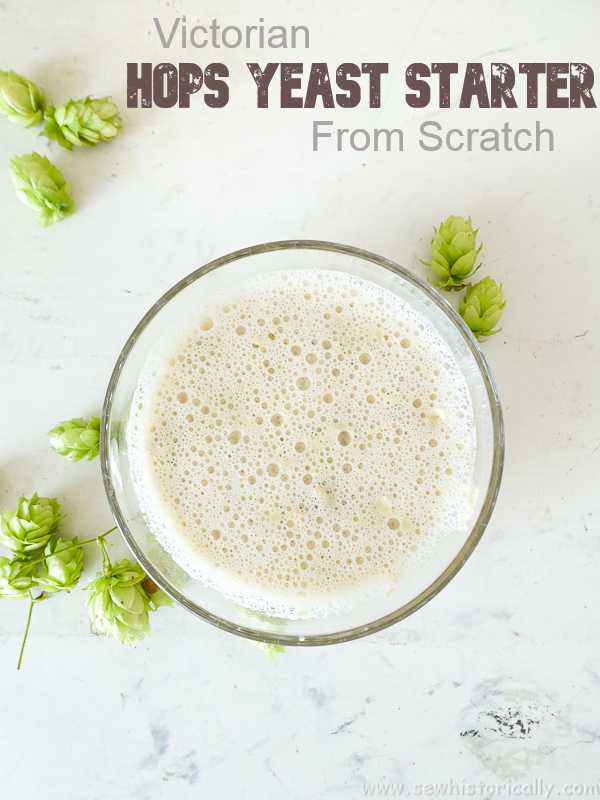
Doesn’t Boiling The Hops Kill The Wild Yeast?
There are wild yeasts on hops but hops aren’t added to homemade yeast because of the wild yeasts but to prevent the yeast starter from spoiling.
Related: Bread Recipe With Wild Yeast (With Honey Water Or Fruit Yeast)
‘Yeast which is made with hops is able to overcome the power of foreign ferments longer than that made without hops, because the bitter of the hops is not suited to bacterial growth, but since one can use but little of a yeast made with hops without injuring the flavor of the bread.’ (Hand-Book Of Household Science, 1902) ‘Hops are not a necessity in the preparation of yeast; they are not a food for the yeast plant, but rather check sour fermentations and permit the yeast to work.’ (Manual for Army Bakers, 1910, p. 26)
Doesn’t Hops Make Bread Bitter?
‘If yeast were taken from strong beer, the quantity of hops employed in the brewing would impart a disagreeably bitter taste to the bread. It must either be yeast from ale, or yeast made on the purpose for the baker.’ (The Saturday Magazine, 1835, p. 237).
However, hops yeast bread still tastes more bitter than you might expect or are used to from other yeast breads.
How To Make Hops Tea
‘To extract this active agent (lupulin) from hops, place them in water […] and allow it to boil for about ten minutes (fifteen minutes in the case of very fresh hops). Longer boiling will extract a bitter flavor. One-half ounce to 1 ounce of fresh hops to each gallon of water should be used, or generally twice this amount of compressed hops according to their strength […]
The resulting liquid is commonly called “hop tea.” If it is desired to make the whitest bread possible the hops should be strained out. If they are left in the solution they make it a trifle darker and small pieces of the hops may be found in the bread. […]
Porcelain or granite ware should, if practicable, be used in boiling hops […] as tinware or iron cause the hop tea […] to take on a darker color, and the bread produced will not be as white as it otherwise would be. Clean hard wood, glass, or porcelain-lined receptacles should be used for yeast, as otherwise certain chemical action might take place that would either darken the solution or spoil it altogether.’ (Manual for Army Bakers, 1910, p. 28f)
Hops tea looks either golden like beer, lemon yellow or reddish. And it usually smells slightly of garlic.
Why Add Malt Or Sugar?
The last Victorian hops yeast starter that I made contained potatoes. But because my Victorian hops potato yeast starter failed, I made hops starter without potatoes this time. If Victorian hops yeast starter didn’t contain potatoes, malt was usually added to the starter.
Malt – as well potatoes – contain maltose which is yeast food, also known as yeast nutrients, which helps the yeast to grow and make a delicious loaf of bread! Malt is still added today to homemade and store-bought bread. You can either make your own malt by sprouting barley and drying it in the oven, or use enzyme active malted flour instead.
Related: Sprouted Sourdough Bread From Scratch – No Flour & No Yeast!
Flour ‘should be strong in gluten – a deficiency in starch should be made up by the addition of sugar. Cane or malt sugar is best.’ (Manual for Army Bakers, 1910, p. 29f) ‘The addition of molasses to some of these breads also accelerates the proving. […] Sugar, glucose, molasses and malt extracts, potatoes and boiled cornstarch are yeast foods, and are used with yeast to make it grow and develop. For this reason it is added to yeast and ferment. […]
Bakers use malt extract, malt flour and yeast foods to improve the flavor and add moisture to the bread; these preparations also stimulate and quicken fermentation, saving sugar and lard. […] Sugar is used in breads to aid fermentation, to give moisture and flavor to the crumb and color and bloom to the crust. […] Malt extract is added to breads to act as a yeast food and act on the flour by softening the gluten and while baking acts on the starch, changing the starch into a form of sugar.’ (Bakers’ Bread, 1918)
Whole-Wheat Or White Flour?
‘Yeast which is made in part of Graham flour [whole wheat flour] rises light sooner than that which is made of white flour alone, and does not affect the color of the bread.’ (The Young Housekeeper’s Friend, 1871)
‘The variety of flours used in the different parts of this country often make it difficult to work the same recipes equally well in all places. Bakers coming from the East find it hard to work with the flours of the West, and vice versa […]
Where different grades of flour are used it is best to use the stronger flour for the sponge and the weaker for doughing. […] A sponge of weak flour should be set tighter than a sponge of stronger flour. […] All dark flours [whole wheat flour] which contain more or less bran prove more rapidly than the white flours; they require less yeast, and also less proof in baking. The addition of molasses to some of these breads also accelerates the proving.’ (Bakers’ Bread, 1918)
Why Scald The Flour?
‘Flour is used in the preparation of yeast – to furnish starch, albuminous matter (gluten), and phosphates for the growth of the yeast plant. […] The granules of starch are bound together into cells […] To rupture these cells and expose the starch to the action of the yeast the application of hot water is necessary. This process is generally called “scalding” the flour.’ (Manual for Army Bakers, 1910, p. 29f) And ‘if the flour is not scalded, the yeast will soon become sour.’ (The Young Housekeeper’s Friend, 1871)
‘It really makes no difference whether […] the flour batter may be added to the hop tea, which should not boil thereafter; or, […] by adding sufficient hop tea to dry flour, and the remainder of the hop tea […] when both it and the batter have cooled to a temperature below that at which the yeast plant is killed (preferably about 90°F).’ (Manual for Army Bakers, 1910, p. 28f)
Soft Vs. Hard Water
‘Hard water retards fermentation, while a soft water accelerates it; therefore when hard water is used it is advisable to use more yeast. […] the water for doughing is usually taken several degrees cooler than the water for setting sponge.’ (Bakers’ Bread, 1918)
‘Fresh soft water should be used in the preparation of yeasts […] Long boiling of water removes the air which promotes fermentation. Salt water (that is, sea water) may be used in the preparation of doughs and sponges, no salt being added to the mixture. Hard water retards the working of yeast.’ (Manual for Army Bakers, 1910, p. 31)
Should I Add Salt?
‘Salt may also be added to check undesirable acid fermentations that may set up accidentally in the yeast. In the absence of hops salt is always used and generally in addition to them. The amount is from 1 to 2 tablespoonfuls to each gallon of water. Used in small quantities, salt renders fermentation more uniform, thus giving a more even grain to the loaf. In larger quantities salt would retard yeast fermentation.’ (Manual for Army Bakers, 1910, p. 29)
‘Salt is used in yeast sometimes as a preservative, and it should be put in the yeast only after fermentation is complete. Where yeast is made fresh often, salt is better left out. In breadmaking it is used as a flavor, and also as a check on fermentation. Larger quantities may be used in the hot season to prevent souring. Salt should not be used in setting sponge; it is better if used in doughing.’ (Paul Richard’s Pastry Book, 1907, p. 99)
‘Many bakers object to the use of salt in the yeast because salt checks fermentation. For this reason, if salt is used it is put in as a preservative after the yeast is ready for use to prevent souring. […] The addition of salt prevents the forming of too much acidity.’ (Bakers’ Bread, 1918)
5+ Victorian Hops Yeast Starter Recipes
Victorians knew different types of homemade yeast. If yeast was made from scratch, it was called maiden yeast, virgin yeast or head yeast. Maiden yeast could be used to make stock yeast – a second starter or preferment – or other fermented doughs, such as potato ferment, or could be used directly to make bread dough. The difference between stock yeast and maiden yeast is that stock yeast is stronger and the starter rises faster. Stock yeast was then used to make bread dough.
The following recipes are all original Victorian and Edwardian hops yeast starter recipes – scroll down for my adapted recipe.
‘Head yeast is developed spontaneously from wild yeast […] and is generally prepared only as a starter for a stronger yeast. It may, however, be used directly in the dough or sponge the same as stock yeast.’ (Manual for Army Bakers, 1910, p. 31f)
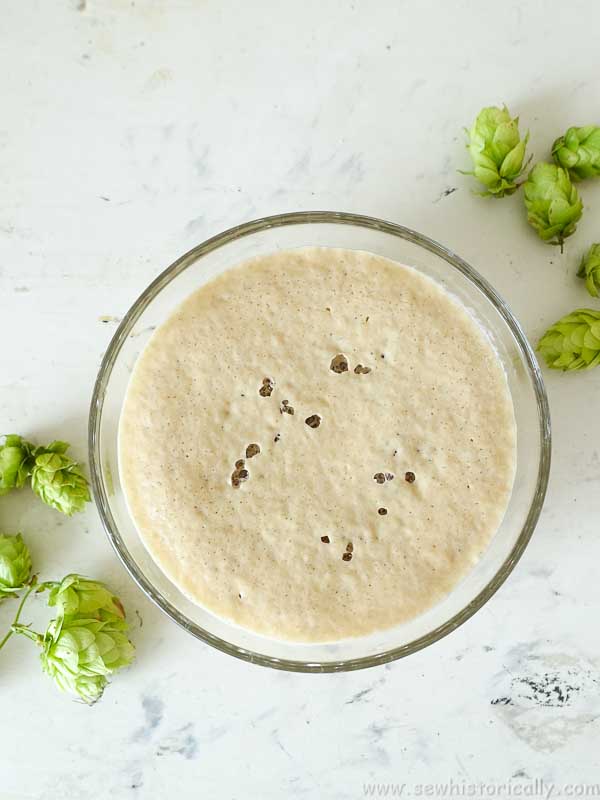
Hops Yeast Starter With Flour – Maiden Yeast
This is a basic homemade yeast starter with hops and flour.
- 5 quarts water
- 1/2 ounce fresh hops
- 10 ounces malt
- 1 1/4 pounds flour
‘Put the water on the stove; add the hops, and boil for about eight or ten minutes. This preparation is known as “hop tea.” Mix the dry flour and malt together in a keg or other suitable receptacle; add sufficient boiling-hot “hop tea” to make a medium thick paste and mix well. […]
Stain the remainder of the “hop tea” into a separate jar or keg and set both aside until they have cooled to about 80° or 90° F., then pour the “hop tea” into the flour and malt mixture. Set in a warm, even temperature; in about twenty-four hours spontaneous fermentation will have set up and foam will be seen to gather on the surface, a deep light scum will rise and a strong beer odor will be present.
In about forty-eight hours the scum will begin to settle and soon thereafter will disappear from the surface of the liquid. The yeast is ready for use as soon as it begins to settle. It should now be set in a cool place, where it will keep from eight to ten days. […]
It is possible to get good results by omitting the hops and malt, but in case they are omitted about 1 1/2 ounces of sugar and 1 ounce of salt per gallon of water should be added.’ (Manual for Army Bakers, 1910, p. 31f)
Hops Yeast Starter Without Flour – Maiden Yeast
This hops yeast starter is made without flour and basically beer brewed for baking. In the Victorian era, this type of homemade yeast starter was also called malt yeast. Malt yeast is said to be stronger than yeast starter with flour. This recipe also uses three times more hops than the recipe above.
‘Malt and stock yeast. Both are stock yeasts, but the malt yeasts are the stronger of the two. In the stock yeasts a flour batter is used with a small quantity of malt, while in the malt yeast only malt is used without the scalded flour. The stronger malt yeast ripens the doughs more rapidly and are used for sponge and dough when a short process is desired, the same as if using compressed yeast. The stock yeasts with flour batter are also used straight for sponges, but are more used in connection with a potato ferment.’ (Bakers’ Bread, 1918)
- 1 handful hops
- 1 quart water
- 1 handful malt
- a little sugar
‘Making yeast from the beginning […] Take a handful of hops and boil in a quart of water for half an hour; strain off the hops and put the liquor in a strong bottle with a handful of malt and a little sugar; cork up and tie securely with wire, and let it stand in a warm place for forty-eight hours. Then it will be ready to start about two gallons of stock with.’ (Paul Richard’s Pastry Book, 1907, p. 99)
I poured the homemade hops yeast starter into a clean swing-top beer bottle, closed the lid and let it ferment for 48 hours at room temperature. After two days, the malt yeast looked bubbly. And there was a smell between stale beer and the acetone smell of some sourdoughs.
Hops Yeast Starter With Bran – Maiden Yeast
This Victorian yeast starter from scratch is made with bran instead of flour.
- 4 tbsp bran
- 1 tbsp hops
- 1 quart water
- flour
- optional: salt + leaven
‘Four table spoonfuls of bran or shorts, and one of hops are boiled in a quart of water, and set by the fire to ferment. A small quantity of salt to the water, wherewith the flour is kneaded, is an improvement. With this, however, the practice is to use leaven saved from a former baking.’ (The Domestic Encyclopedia, Or, A Dictionary of Facts and Useful Knowledge, Chiefly Applicable to Rural & Domestic Economy, 1821, p. 514)
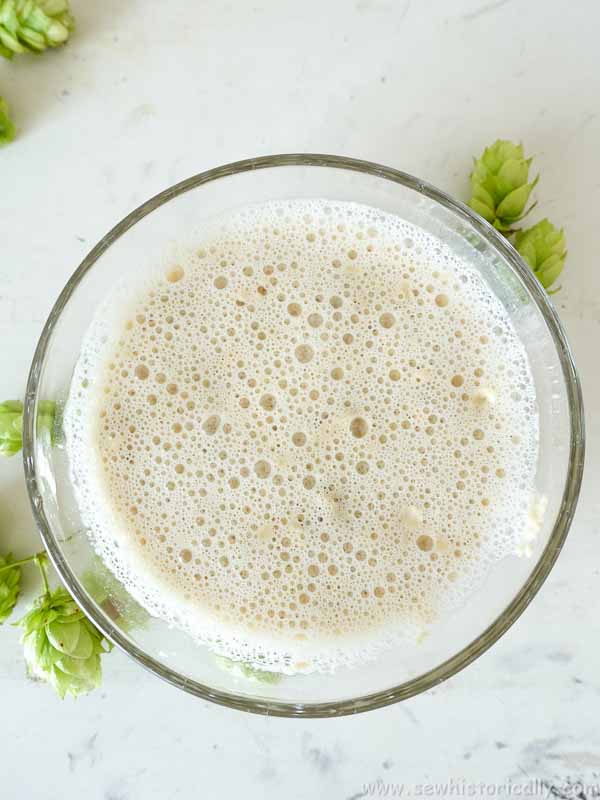
How To Make Stock Yeast With Maiden Yeast
‘A quarter of a peck of malt is then to be boiled for 8 or 10 minutes, in 3 pints of water; when one quart must be poured off the grains into the first vessel: as soon as the liquor becomes cool, such vessel ought to be removed towards the fire, or to a temperature of about 70 or 80° of Fahrenheit’s thermometer.
In the course of 30 hours, the fermentation will commence ; when 2 quarts of a similar cool decoction (made, we suppose, from the same malt), must be mixed with this yeast, in the second, or larger vessel; and be repeatedly stirred in the manner practised in common vats. As the fermentation increases, a greater portion of the like decoction must be added, and be worked in the largest vessel: thus, at length, a sufficient quantity of yeast will be produced’ (Domestic Encyclopedia Or A Dictionary Of Facts, And Useful Knowledge Vol 4, 1802)
‘I made an infusion of malt and a decoction of hops […] To this preparation, I added my two spoonfuls of yeast; let the mixture stand 24 hours ; then poured off the watery part; mixed the sediment with an increased proportion of the malt and hops; which fermented, and produced yeast enough to work a gallon of strong-beer, that yielded a pint of very fine yeast, of which excellent bread was made.’ (Domestic Encyclopedia Or A Dictionary Of Facts, And Useful Knowledge Vol 4, 1802)
Soft Hops Yeast – Stock Yeast
This second starter or preferment is made with very little flour.
- 3 pints water
- small handful of hops
- 6-7 tbsp flour
- 1 tsp salt
- 1 gill of yeast
‘To three pints of water put a small handful of hops, or if they are in compact pound papers, as put up by the Shakers, half a handful; boil them about half an hour. If the water wastes, add more. Put into the jar six or seven table-spoonfuls of flour, and a teaspoonful of salt. Set it near the kettle, and dip the hop tea, as it boils, into the jar through a small colander or sieve. When you have strained enough of the tea to wet all the flour, stir it, and let none remain dry at the bottom or sides of the jar; then strain upon it the remainder of the hop-water, and stir it well. This mixture should be about the consistency of batter for griddle-cakes. The reason for straining the hop-water while boiling is, that if the flour is not scalded, the yeast will soon become sour.
After it becomes cool (but not cold), stir in a gill of good yeast; set it in a slightly warm place, and not closely covered. Do not leave an iron spoon in it, as it will turn it a dark color, and make it unfit for use. When the yeast is fermented [in 36 to 48 hours], put it in a cool place, covered close.’ (The Young Housekeeper’s Friend, 1871)
‘This stock yeast will keep for a month in a cool place, and can be used to make new stock with, […] baking soda added and put in a jar in the ice box.’ (Bakers’ Bread, 1918)
Hops Stock Yeast
This Victorian stock yeast recipe uses almost twenty times as much flour as the recipe above.
- 2 quarts water
- large handful of hops
- 3 pints wheat flour
- 1/2 pint maiden yeast
‘Have ready, in a kettle over the fire, two quarts of boiling water; put into it a very large handful of hops, (as fine and fresh as possible,) and let the water boil again with the hops in it, for twenty minutes or more. Sift into a pan three pints of wheat flour. Strain the liquor from the hops into a large bowl, and pour half of it hot over the flour. Stir it well, and press out all the lumps till it is quite smooth. Let the other half of the liquid stand till it is cool, and then pour it gradually to the rest; mixing it well, by stirring as you proceed.
Then take half a pint of good strong yeast – brewers’ or bakers’ yeast, if you can get it fresh; if not, you must use some that has been left from your last making, provided it is not the least sour; stir this yeast into the mixture of hop-water and flour; put it immediately into your jug or bottles, and cork it loosely till the fermentation is over, (which should be in an hour,) and it will then be fit for use. Afterwards cork it tightly. It will keep better if you put a raisin or two into the bottom of each bottle, before you pour in the fresh yeast. Into a stone jug put half a dozen raisins.’ (Miss Leslie’s New Receipts For Cooking, 1852)
Stock Yeast With Bran
This stock yeast is made with bran instead of flour.
- 2 quarts water
- 1 pint bran
- small handful hops
- 3-4 tbsp beer yeast
- 2 tbsp brown sugar or treacle
‘Boil for ten minutes, in two quarts of water, one pint of bran, and a small handful of good hops; strain it through a sieve, and when milk warm, add three or four table-spoonfuls of beer yeast, and two of brown sugar or treacle: put it into a wooden stoup or jug; cover it, and place it before the fire to ferment. It may be bottled, tightly corked, and kept in a cool place.’ (The Cook’s Own Book, And Housekeeper’s Register, 1854)
‘Yeast made in this manner will keep good for a fortnight in warm weather; in cold weather longer. If your yeast appears to be a little changed, add a little saleratus [baking soda] to it before you mix it with your bread. If it does not foam well, when put in, it is too stale to use.’ (The American Housewife: Containing the Most Valuable and Original Receipts in All the Various Branches of Cookery, 1841, p. 54)
Bread With Homemade Yeast Starter
- 6 pound flour
- 1 quart homemade yeast starter
- enough warm water (or a decoction of malt)
‘The whole is now to be kneaded together proper vessel, covered with a cloth, and suffered to stand for 12 hours, or till it be sufficiently fermented; when it should be formed into loaves, and baked.’ (Domestic Encyclopedia Or A Dictionary Of Facts, And Useful Knowledge Vol 4, 1802)
Good White Bread With Homemade Yeast Starter
- 6 pounds flour
- 2 1/2 pints lukewarm water
- 8 tbsp liquid homemade yeast starter
- 2 ounces salt
‘Put about a pint of the warm water to the yeast, and mix them well, by beating them together with a whisk. Let the salt be put to the remaining part of the water, and stirred till completely dissolved. Then put both quantities of the fluid gradually to the flour, and knead the mass well till the whole is properly mixed.
The dough thus made must stand four or five hours, that is, till the exact moment of its being fully risen, and before it is sensibly perceived to fall. It is then to be formed into loaves, and immediately placed in the oven.’ (Domestic Encyclopedia Or A Dictionary Of Facts, And Useful Knowledge Vol 1, 1802)
Wild Yeast Bread With Hops Yeast Starter – Adapted Recipe
Hops Yeast Starter – Maiden Yeast
This is the original historical recipe from above ‘Hops Yeast Starter With Flour – Maiden Yeast’ except that I reduced the amount of the ingredients.
I’ve tried different of the historical hops yeast recipes above: maiden yeast, stock yeast, hops yeast starter with and without flour. But there was no big difference between using maiden yeast directly to make bread or turning maiden yeast into stock yeast first and then using this to make bread – except that hops bread with stock yeast tasted more bitter.
- 1 3/4 cups (330ml) water
- 3 (1g) fresh hops
- 2 tbsp (20g) malt – enzyme active malt flour
- 4 tbsp (40g) flour – whole-wheat or first clear flour
Make Hops Tea
Combine hops and water in a saucepan. Bring it to a boil and continue to cook it covered for 8 minutes. Then remove the hops. Hops tea usually smells slightly of garlic.
Make Hops Yeast Starter
Combine malt and flour in a glass or porcelain bowl (don’t use metal). Pour the boiling hops tea over the malt and flour. Stir vigorously until smooth
Let Ferment For 48 Hours
Cover the hops yeast starter with a kitchen towel and let it stand at room temperature for 48 hours. It isn’t necessary to stir the hops yeast starter in that time because the hops prevent the growth of mold.
After two days, the homemade hops yeast starter looks bubbly and still smells slightly of garlic.
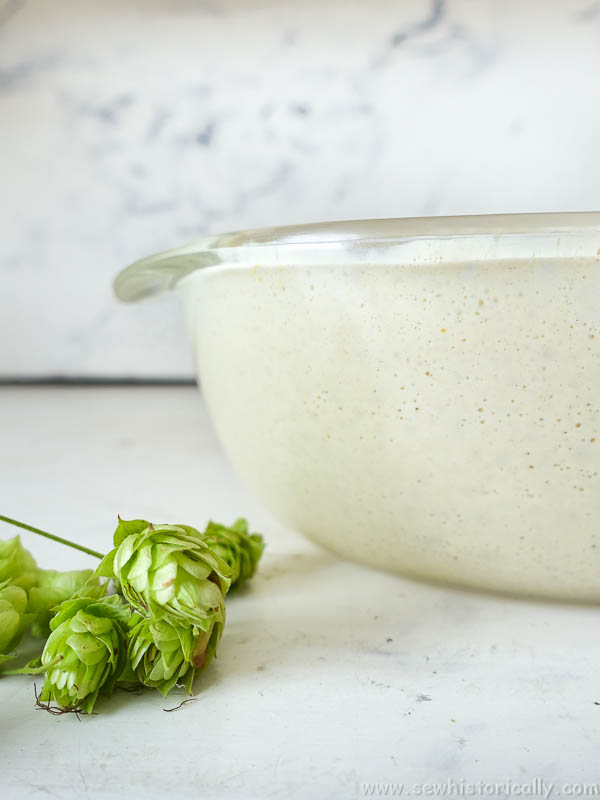
Hops Yeast Bread
- 1 1/2 cups (300ml) homemade hops yeast starter
- 5 cups (600g) flour – white flour or all-purpose flour
- 1 cup (200ml) cold water
- 1 tsp salt
Make Bread Dough
Stir all ingredients for the hops yeast bread together with a spoon until well incorporated. Then fold the dough. Add more flour if the dough is too sticky.
Let Rise Overnight
Put the dough into a greased pan. Use a large pan because hops yeast is very active! Let the dough rise for some hours or overnight until doubled or tripled in size.
Bake The Bread
Preheat the oven to 400°F (200°C). And bake the hops yeast bread for about 45 minutes.
